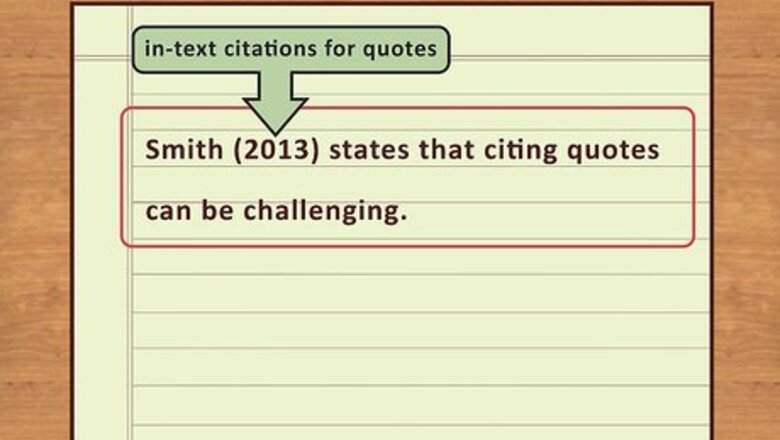
views
Cite a Quote in APA Style
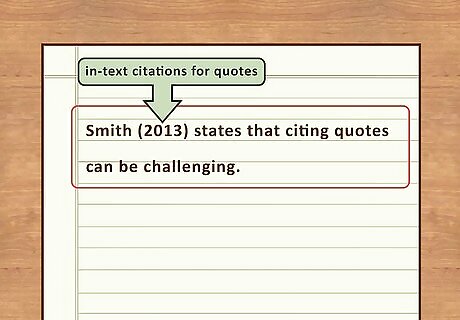
Use in-text citations for quotes. Place parentheses with the proper citation inside after directly after quoted material. APA style uses the author-date message.This means that if you write the name of an author you are quoting, you must follow that name with the year of publication in parentheses.Example:Smith (2013) states that citing quotes can be challenging.
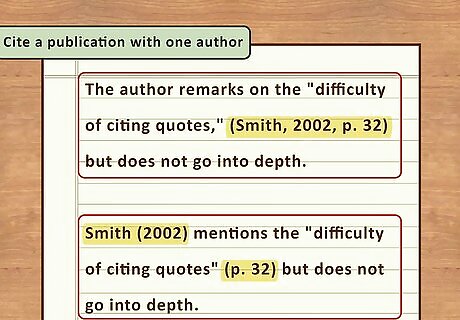
Cite a publication with one author. Publications include books, newspapers, journal articles, magazines, etc. The author’s last name, the year of publication, and the page number (preceded by a ‘p.’) should appear in parenthesis after the quote. If you state the author’s name in your sentence, the name must be followed by the year of publication in parenthesis and the quote must be followed by the page number. Follow the same procedures if the book has multiple authors.The author remarks on the "difficulty of citing quotes," (Smith, 2002, p. 32) but does not go into depth.orSmith (2002) mentions the "difficulty of citing quotes" (p. 32) but does not go into depth.
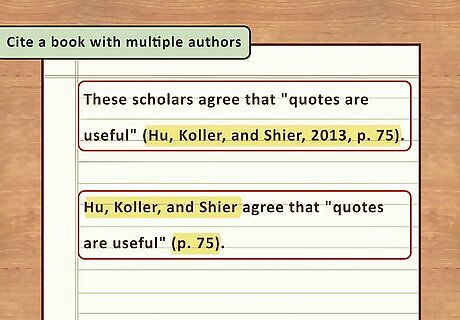
Cite a book with multiple authors. This should include the authors' last names, the year of publication, and the page number. These scholars agree that "quotes are useful" (Hu, Koller, and Shier, 2013, p. 75).orHu, Koller, and Shier agree that "quotes are useful" (p. 75).
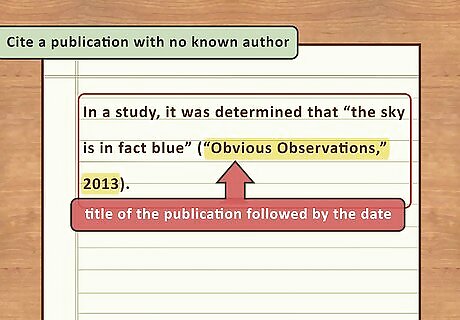
Cite a publication with no known author. Instead of using an author’s name for the in-text citation, use the title of the publication followed by the date. In a study, it was determined that “the sky is in fact blue” (“Obvious Observations,” 2013).

Cite a web page. If possible, cite a web page like any other document, using the author-date style. If there is no author name or date available, use a shortened version of the web page title in your parentheses, along with n.d (which stands for “no date”). If a web page does not have page numbers, signal which paragraph your quote is from by writing ‘para.’ (which stands for paragraph) followed by the paragraph’s number.Another study showed that “clouds are white” (“More Obvious Observations,” n.d., para. 7).
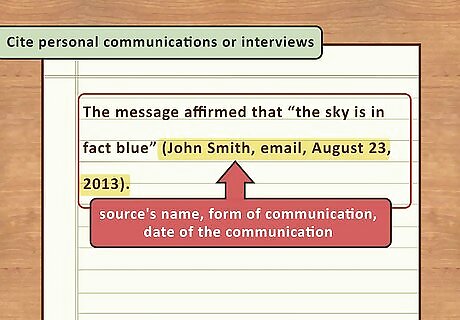
Cite personal communications or interviews. Personal communications like e-mail and interviews are not considered recoverable data, so they are not recorded in your References list at the end of the work. Include all of the following in a parenthetical citation, placed as close after the quote as possible: Your source's name, form of communication, date of the communication.The message affirmed that “the sky is in fact blue” (John Smith, email, August 23, 2013).
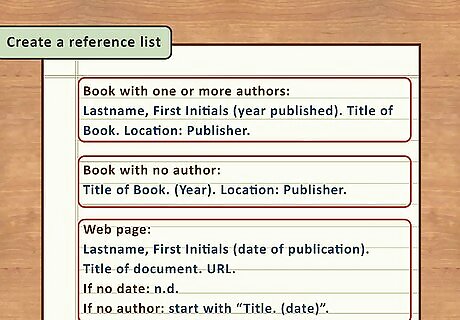
Create a reference list. This is where you list all of the sources you have quoted in your paper. List your references in alphabetical order. Keep in mind that all lines after the first line of each entry should be indented one half-inch from the left margin.Book with one or more authors: Lastname, First Initials (year published). Title of Book. Location: Publisher.Book with no author:Title of Book. (Year). Location: Publisher.Web page:Lastname, First Initials (date of publication). Title of document. URL.If there is no date, write n.d. If there is no author, start with "Title. (date)."
Cite a Quote in MLA Style
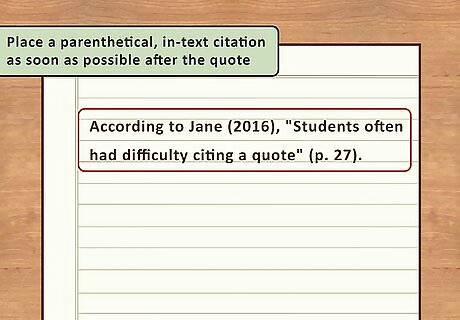
Place a parenthetical, in-text citation as soon as possible after the quote. How you make the in-text citation depends on what kind of source you pulled the quote from.
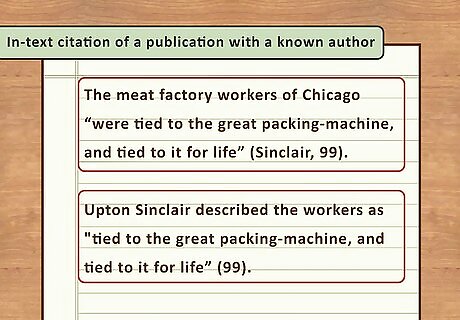
Create an in-text citation of a publication with a known author (book, magazine, journal article, newspaper). Provide a word or phrase (the author’s name) and the page number. If you state the word or phrase in the sentence, you do not need to add it to the in-text citation.The meat factory workers of Chicago “were tied to the great packing-machine, and tied to it for life” (Sinclair, 99).orUpton Sinclair described the workers as "tied to the great packing-machine, and tied to it for life” (99).
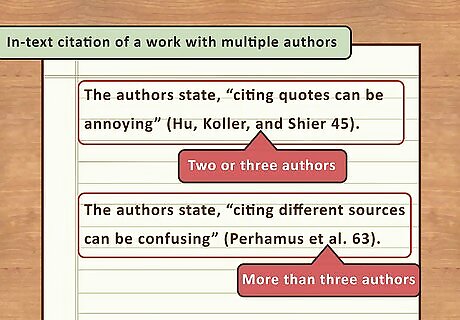
Create an in-text citation of a work with multiple authors. If there are three or less authors, list all of the authors’ last names in alphabetical order within the parentheses followed by the page number. If there are more than three authors, write the last name of the author who appears first in the alphabet, followed by "et al." and the page number.Two or three authorsThe authors state, “citing quotes can be annoying” (Hu, Koller, and Shier 45).More than three authors:The authors state, “citing different sources can be confusing” (Perhamus et al. 63).
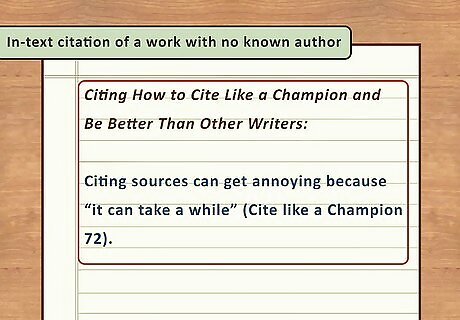
Create an in-text citation of a work with no known author. Use a shortened title of the work in place of an author’s name.Citing How to Cite Like a Champion and Be Better Than Other Writers:Citing sources can get annoying because “it can take a while” (Cite like a Champion 72).
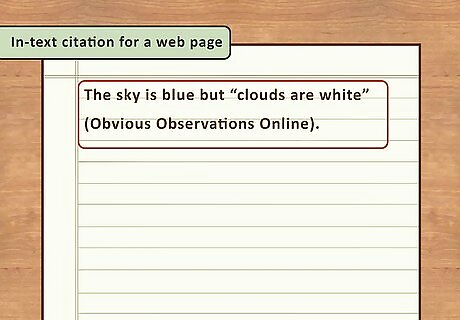
Create an in-text citation for a web page. List either the web page’s author, website name, or article name in parentheses. You do not need to put a page number.The sky is blue but “clouds are white” (Obvious Observations Online).

Create an in-text citation for an interview or personal communication. Include the first item that appears in that source's listing on the Works Cited page--usually the interviewee's last name.An email message confirmed that “the sky is indeed blue” (Smith).

Create a Works Cited page. This is where you list the full bibliographical information for each source that you quoted or cited in your paper. You should list your sources in alphabetical order. Use the following formats:Book with one author:Lastname, Firstname. Title of Book. City of Publication: Publisher, Year of Publication. Medium of Publication.Note: The Medium of Publication is "Print" for paper books. Other media include Web and Radio.Book with multiple authors:Lastname, Firstname of first alphabetical author, then Firstname Lastname for other authors. Title of Book. City of Publication: Publisher, Year of Publication. Medium of Publication.Book with no known author:Title of publication. City of Publication: Publisher, Year of Publication. Medium of Publication.Web page:“Name of Article.” Name of Website. Name of website owner, date of publication. Web. Date of access.Note: Write n.d. if no publishing date is listed.Personal interview:Lastname, Firstname of interviewee. Personal interview. Date.Published interview:Lastname, Firstname of interviewee. Interview with (Name of Interviewer). Publication or program (year): page numbers if applicable. Medium of publication.Personal message:Lastname, Firstname of sender. “Title of Message.” Medium. Date.
Cite a Quote in CMS

Use CMS if you prefer footnotes or endnotes to in-text citation. CMS is good for research papers and essays with a lot of sources and quotations.
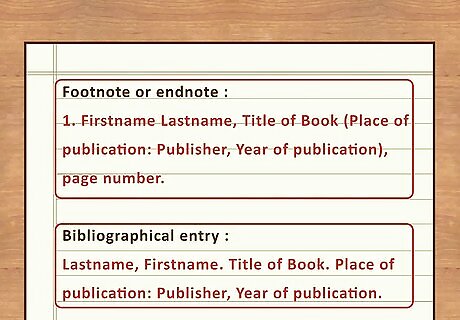
Decide whether you are going to use footnotes or endnotes. After each in-text citation, you must added a superscript reference number. (It looks like this:) Each superscript number correlates with either a footnote or an endnote. Footnotes are found at the bottom of each page and include all of the bibliographic information for the work that you are citing. Endnotes appear at the end of a paper, similar to how Works Cited pages look, though endnotes are formatted differently. (The differences will be discussed in the following steps.)
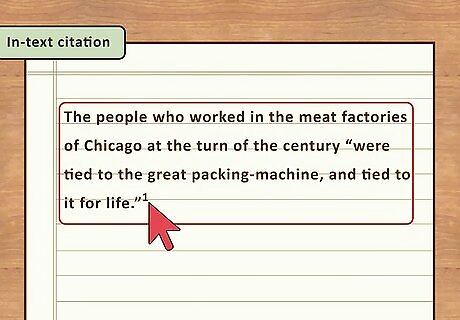
Create an in-text citation. Regardless of the length of the quote, insert a raised number after each quote. This number will correlate to the footnote that will appear at the bottom of the page.The people who worked in the meat factories of Chicago at the turn of the century “were tied to the great packing-machine, and tied to it for life.”
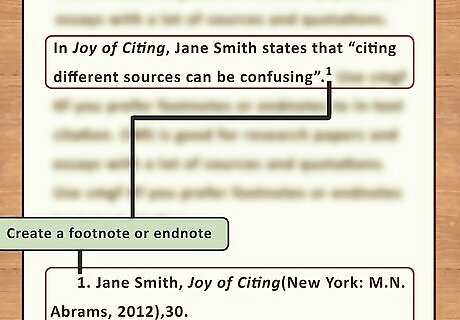
Create a footnote or endnote. Both notes are formatted in the same way. If you choose to use footnotes, place them at the bottom of a page that has superscripts. Only put footnotes on the page where their correlating superscripts are. You must have a footnote for every superscript you use. If you choose to use endnotes, put them on their own page under the title of ‘Notes’ following the text of your essay. You must have an endnote for every superscript you use.
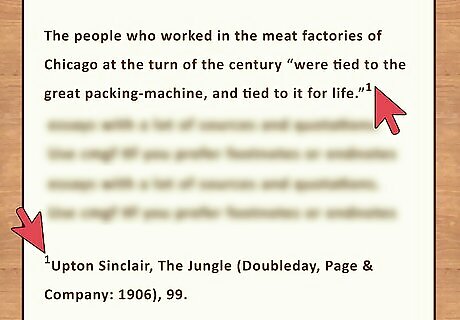
Create a footnote/endnote for a quotation from a book. You must list: the author’s firstname lastname, Title of Book (Place of publication: Publisher: Year of publication), page number. The people who worked in the meat factories of Chicago at the turn of the century “were tied to the great packing-machine, and tied to it for life.” Upton Sinclair, The Jungle (Doubleday, Page & Company: 1906), 99.
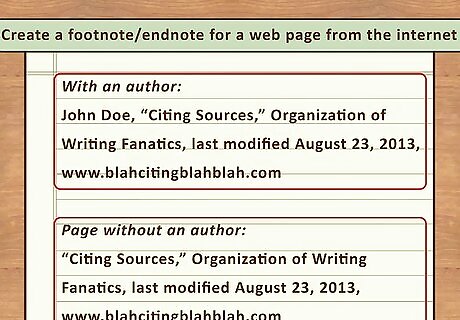
Create a footnote/endnote for a web page from the internet. You must list: Firstname Lastname, “Title of Web Page,” Publishing Organization or Name of Website in Italics, publication date and/or access date if available. If the web page does not have an author, list: “Title of Web Page,” Publishing Organization or Name of Website in Italics, publication date and/or access date if available, URL.With an author:John Doe, “Citing Sources,” Organization of Writing Fanatics, last modified August 23, 2013, www.blahcitingblahblah.comPage without an author:“Citing Sources,” Organization of Writing Fanatics, last modified August 23, 2013, www.blahcitingblahblah.com
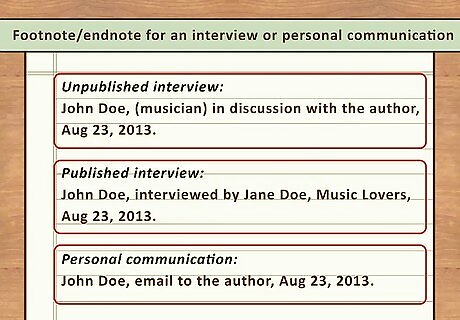
Create a footnote/endnote for an interview or personal communication. For an unpublished interview, list: Name of interviewee, (job) in discussion with the author, date. For a published interview, list: Name of interviewee, interviewed by Name of interviewer, Company or Organization, date. For personal communication, list: Name of person, type of communication, date.Unpublished interview:John Doe, (musician) in discussion with the author, Aug 23, 2013.Published interview:John Doe, interviewed by Jane Doe, Music Lovers, Aug 23, 2013.Personal communication:John Doe, email to the author, Aug 23, 2013.
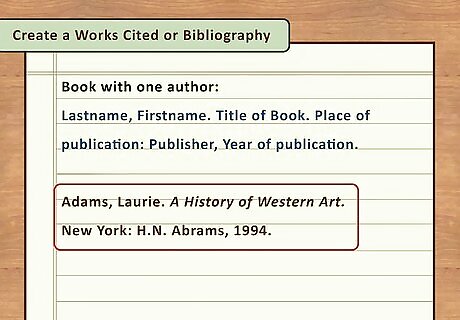
Create a Works Cited or Bibliography. This is optional. Refer to your specific instructions to see if you need a works cited or bibliography. Title the page ‘Works Cited’ if you only list sources that you actually cite in your paper. Title the page ‘Bibliography’ if you list every work you used in research that you didn’t cite, along with the works that you cited in your paper. List all works and resources in alphabetical order. To list materials, follow the specific format for the kind of source you are using (listed below):'Book with one author:Lastname, Firstname. Title of Book. Place of publication: Publisher, Year of publication.Book with two authors:Lastname, Firstname and Lastname, Firstname. Title of Book. Place of publication: Publisher, Year of publication.Book with no known author:Title of Book. Place of publication: Publisher, Year of publication.Web page with author:Lastname, Firstname. “Title of Web Page.” Publishing Organization or Name of Website in Italics. Publication date and/or access date if available. URL.Web page without an author:“Title of Web Page.” Publishing Organization or Name of Website in Italics. Publication date and/or access date if available. URL.Published Interview:Lastname, Firstname of interviewee, place where interview was held, by Interviewer's Firstname Lastname, date.












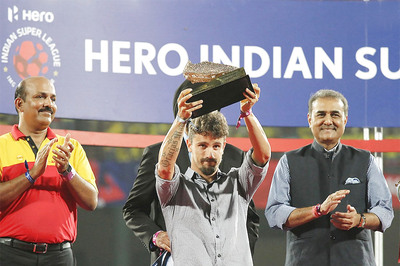

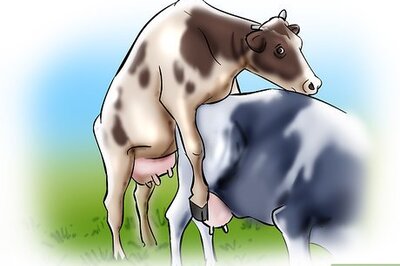

Comments
0 comment